THE Straw War took place in the village of Canudos, in the hinterland of Bahia, between 1896 and 1897.
The site was led by Antônio Conselheiro and had become an attraction center for the marginalized populations of the Northeast.
In this way, the government of Bahia and the central government decided to end their installations. The conflict is considered the biggest resistance movement to the oppression of large rural landowners in Brazil.
The Canudos War was described by Euclides da Cunha in the book “Os Sertões”, published in 1902.
Causes of the War of Straws
The village of Canudos was formed by residents who were fleeing the extreme poverty in which they lived in the northeastern hinterland.
In a short time, the place brought together 25,000 people, constituting, according to the landowners, the focus of monarchists who wanted to overthrow the newly established republic. However, the sertanejos only went to the place in search of better living conditions.
It must be remembered that the change in the political regime did not mean significant changes in the country's economy. The economic structure of Brazil operated on the basis of large estates, where monoculture and the exploitation of labor that lived in poverty predominated.
The community of Canudos
Around 1893, in the arraial de Canudos, on the banks of the Vaza-Barris river, in Bahia, a group of faithful gathered, followers of Antônio Conselheiro. This was a blessed, born in Ceará, who preached the salvation of the soul for those who followed him.
You blessed or advisers they walked through the sertão, preaching a form of popular Catholicism and were followed by dozens of believers. Therefore, they were also seen as a threat by the Catholic Church.
After wandering through the hinterlands of Pernambuco and Sergipe, Conselheiro walked through the interior of Bahia and settled in Canudos. In this place they built the “holy city of Belo Monte”, which became a refuge for the poor in the region.
Canudos was a community where social differences did not exist, where herds and crops belonged to everyone. This socio-economic model attracted thousands of people from the countryside.
In 1896, the year the war began, Belo Monte had more than 5,000 families. The defense of the stronghold was maintained by ex-jagunços, men who worked as security guards for farmers or ex-cangaceiros, people who lived in backcountry bands and attacked rural properties.
The destruction of Canudos
For the sertanejos, the camp was the “promised land”. However, for the priests who lost their faithful, and the landowners who lost their workers, it was a “stronghold of fanatics” that had to be eliminated.
Priests and colonels pressured the governor of Bahia to destroy the Arraial. The latter sent two military expeditions that were defeated by Conselheiro's men.
Vice President Manuel Vitorino, who occupied the presidency as a substitute for Prudente de Moraes, sent the third expedition, commanded by Colonel Moreira César. For the government it was a matter of military and national honor to annihilate the “fanatics”. However, this expedition was defeated and Moreira César was killed in combat.
The successive military defeats were explained by the fact that the vast majority of soldiers did not know the region of the caatinga, so familiar to the people of Canudos. Furthermore, the Counselor's men fought for survival and the salvation of the soul, believing that they were waging a holy war.
In Rio de Janeiro, the president was accused of weakness in repressing the movement, considered by many to be a monarchist.
Prudente de Moraes ordered the Minister of War, Marshal Bitencourt, to embark for Bahia and assume direct control of the operations. A new expedition was then organized, with more than 5000 men under the command of General Artur Oscar, with the order to destroy Canudos.
After intense cannon bombardment, the mission was accomplished. Canudos was totally destroyed on October 5, 1897.
Consequences of the War of Straws
The destruction of Canudos was complete and thousands of peasants died in the conflict.
Official troops took no prisoners and even went so far as to unearth the body of Antônio Conselheiro to photograph him. His head was cut off and taken as a trophy, repeating a practice that dates back to the colony.
The central government would still face several revolts in the countryside and in the city, such as the Contestado War and the Vaccine Revolt.
We have more texts on the subject for you:
- old republic
- Antônio Councilor
- Contested War
- Vaccine Revolt
- Exercises on Old Republic


